
Restoration Roundup
Restoration Roundup
Emerald Ash Borer and Riparian Forests
In the inaugural episode of Restoration Roundup, we speak with Patrick Engelken, an entomologist with the U.S. Forest Service in St. Paul, Minnesota. While working to get his graduate degree at Michigan State University, Engelken studied the effects of Emerald Ash Borer (“EAB,” scientific name: Agrilus planipennis Fairmaire in the family Buprestidae) on riparian forests. Although EAB was first discovered in Michigan in 2002, the insects were not introduced to Vermont until 2018. EAB is an invasive species native to northeastern Asia that feeds on all kinds of ash species.
Ash trees provide an important service to ecosystems as a key species in riparian forests. In these ecosystems, their roots help filter out pollutants and sediments; ash trees also help regulate nutrient distribution and cycling, leaf litter deposits, and forest floor temperature. In this episode, Engelken walks us through how EAB is detrimental to ash health, as the insects attack in the phloem layer of the tree. Phloem is a thin layer of cells that transport food around the tree to parts that need it. EAB eats at that thin layer, restricting nutrients from getting to all parts of the tree, and ultimately causing the tree to die. Because of the role ash trees play in riparian ecosystems in this region, the emergence of EAB in Vermont in 2018 poses a threat not only to ash tree health, but also to efforts to promote cleaner water and wildlife habitat for a healthier Vermont.